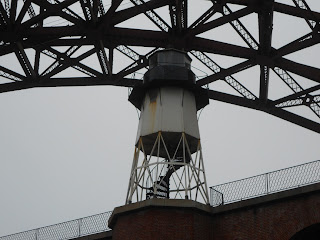 |
| Fort Point under Golden Gate Bridge |
You'll be wise to add Fort Point to your itinerary. Fort Point is one of the most unique historical sites the the United States. One of the reasons this particular fort is so unique has to do in where it's located. The site of Fort Point is directly under the south end of the Golden Gate Bridge and in the Golden Gate National Parks area.. Stand inside or outside the fort gate, look up and you'll see the bottom of the bridge. There's nothing else like it. Today, Fort Point is a National Historic Site administered by the National Park Service.
The Creation of Fort Point
 |
| Interior of Fort Point |
There may not have been a better positioned fort to protect the bay entrance. The Spaniards, the first Europeans to arrive in present day San Francisco, built the Presidio as well as fortifying the cliffs where Fort Point is now located. The Spaniards were concerned with encroachment from the north by both the Russians and the British. The Russians had reached all the way south to around present day Bodega Bay, about 60 miles north of San Francisco. As it turned out, the Russian colony were traders not colonizers and there was never an armed conflict between the two.
As far as California was concerned, and at one time it was called Alta California, the biggest event was the United States takeover from Mexican rule in 1846.That event was followed fairly quickly by the discovery of gold at Sutter's Mill and then the ensuing California Gold Rush. Things changed dramatically and it changed fast. Tens of thousands of people arrived in the area, most of them by sea.
 |
| Cannon on display at Fort Point |
As it turned out, the guns at Fort Point would never fire a shot during the war. According to information published by the National Park Service, there actually was a Confederate vessel, the CSS Shenandoah that did plan to attack San Francisco but on it's way learned that the war had ended. When the Civil War ended in 1865 the fort was garrisoned as a general army defense position as well as a barracks site.
 |
| Lighthouse at Fort Point under Golden Gate Bridge |
Two additional related Western Trips articles and photos you'll find interesting are the Sonoma California Mexican Barracks and Mission and also Sutter's Fort and New Helvetia.
Key Changes in 1892
As the years went by, many technological weapon changes took place. In 1892, the army started to construct new concrete and steel fortifications that would contain breech loading rifled guns. The era of the cannon was coming to an end. The 1906 Earthquake was obviously devastating to San Francisco and the fort wasn't entirely spared. Fortunately it was only moderately damaged. After the earthquake, Fort Point was mostly used for training and for barracks space although the members of the 6th Artillery Coast Guard were stationed there during World War two.
 |
| Fort Point powder keg exhibit |
As happens occasionally with historic sites, their cultural importance sometimes conflicts with modernization. In the case of Fort Point it involved the planned Golden Gate Bridge. The actual plans for the bridge called for the removal of Fort Point. When you visit the fort, you'll see just how close the bridge structure is to the fort. Lucky for all of us the final plans for the bridge worked around the fort. You can see the changes in the Golden Gate Bridge construction and how it accommodated Fort Point.
The future of Fort Point was solidified when President Richard Nixon, in 1970, signed a bill officially making Fort Point a National Historic Site.
Directions to Fort Point
Fort Point is located at the end of Marine Drive on the Presidio of San Francisco. Getting there can be a bit tricky. If you're coming from San Francisco proper or points south of the Golden Gate Bridge, take Highway 101 north and exit right at the Golden Gate Bridge toll plaza but before getting on bridge. Turn right at end of exit ramp and then left onto Lincoln Boulevard. Take the first left onto Long Avenue and follow onto Marine Drive and Fort Point at its end. There is parking available before getting to the fort itself.
When you enter the fort you'll see a large brick fortification with several different replica models of cannon. Some of these are Spanish cannons. The fort has an extensive artifact collection including the powder storage room. It's quite an impressive display. You can also walk to the top of the fort and get a great view of the narrow opening between San Francisco Bay and the Pacific Ocean. Also a great place to get some unique Golden Gate pictures.
An excellent book regarding historic Fort Point is Fort Point: Sentry at the Golden Gate by author John Arturo Martini.
(Photos from author's private collection)
View Larger Map

